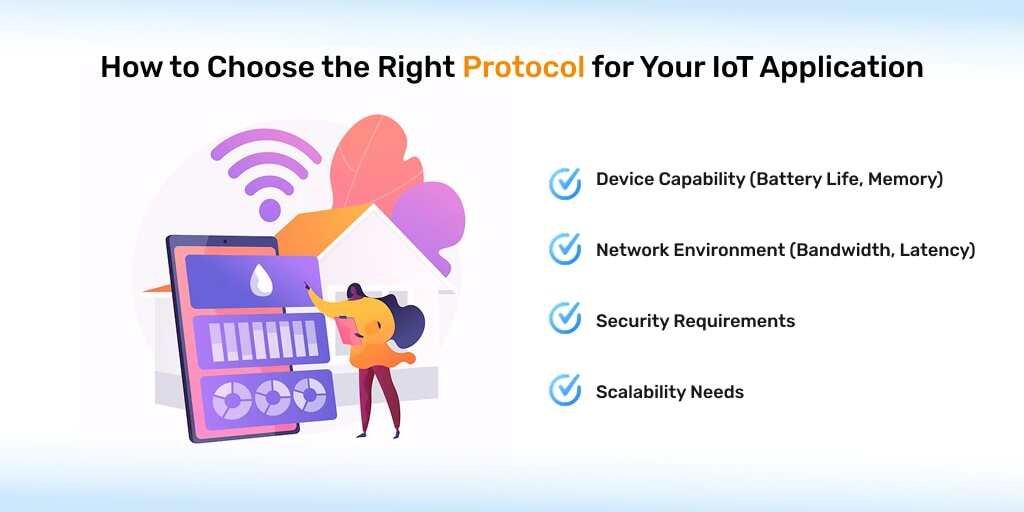Standardized protocols and frameworks are essential for preserving device-to-device connectivity, data security, and system integration as the Internet of Things (IoT) continues to expand. Organizations must comprehend these IoT standards and protocols in order to create solutions that are secure, scalable, and future-proof. The key IoT communication protocols and standards covered in this guide will help you make the best decisions possible to promote innovation and operational excellence in your networked world.
Table of Content
Why IoT Standards and Protocols Matter for Businesses
IoT standards and protocols are the building blocks of device-to-device communication and interoperability in IoT. Without standards, devices from various vendors cannot communicate efficiently, and this results in inefficiency, higher costs, and non-scalability. Organizations employing standardized IoT protocols enjoy seamless interoperability in IoT, accelerated deployments, improved security, and future-proof solutions that integrate easily with future technologies.
Overview of Common IoT Communication Protocols
IoT communication protocols determine how devices talk to one another within networks. Some examples are:
- MQTT (Message Queuing Telemetry Transport) – lightweight and ideal for low-bandwidth networks
- CoAP (Constrained Application Protocol) – most suitable for constrained devices
- HTTP/HTTPS – used most often, especially in web-based IoT applications
- LoRaWAN, Zigbee, and Bluetooth – for wireless IoT communication protocols
Each protocol serves different use cases depending on range, power consumption, and security needs.
Key IoT Standards and Protocols Driving Interoperability
For devices across various companies to interact with each other, international institutions have presented standards like:
IEEE 802.15.4 for Low-Rate Wireless Networks: This standard enables low-power, low-data-rate communications—perfect for battery-powered IoT devices in mesh networks such as Zigbee and Thread.
OneM2M for Machine-to-Machine Communications: OneM2M offers a uniform platform for IoT and M2M communications with the capability for cross-platform interoperability in IoT and easy deployment.
Thread and Z-Wave for Smart Home Devices: Thread enables secure, scalable mesh networking for smart homes, while Z-Wave ensures seamless connectivity and low interference across devices
Top IoT Protocols: MQTT, CoAP, and HTTP Explained
MQTT
A lightweight publish-subscribe protocol ideal for remote monitoring in low-power and low-bandwidth environments. It offers reliable message delivery with minimal overhead, making it perfect for real-time IoT data transmission.
CoAP
Designed for simple devices, using a RESTful model similar to HTTP but optimized for constrained networks. It supports multicast IoT communication protocols and low header size, suitable for resource-limited devices and sensor nodes.
HTTP
While not optimized for IoT, it remains widely used due to familiarity and compatibility with web services. Its stateless architecture and widespread support make it ideal for cloud integration and standard web APIs.
How IoT Standards Ensure Data Security and Compliance
which assists in keeping data secure while it is in transit. Standards assist organizations in meeting data privacy mandates such as GDPR or HIPAA by mandating rules related to authentication, authorization, and auditability. Implementing secure, standardized models preserves data integrity and safeguards IoT networks from cyber attacks.
In addition, most Internet of Things (IoT) standards and protocols facilitate device identity management and secure firmware updates to avoid unauthorized access and vulnerabilities. They are critical to establishing trust in large-scale, networked IoT ecosystems.
Choosing the Right Protocol for Your IoT Application

Device Capability (Battery Life, Memory)
Lightweight protocols such as MQTT or CoAP are the best fit for low-energy devices with limited processing and memory.
Network Environment (Bandwidth, Latency)
Efficient protocols such as MQTT and CoAP reduce data load and improve responsiveness in networks with low bandwidth or high latency.
Security Requirements
Encryption- and authentication-enabled protocols like MQTT with TLS ensure protection of sensitive information.
Scalability Needs
If your system has to support thousands of connected devices, low-overhead protocols and publish-subscribe patterns such as MQTT are more scalable.
MQTT is perfect for real-time analytics in logistics, for example, and CoAP is suited for smart home systems. A protocol that is well-suited maximizes performance, decreases cost, and provides long-term success.
Future Trends in IoT Protocol Development

Edge-Native Protocols for Real-Time Decision-Making
New protocols are being developed to facilitate real-time processing at the edge, lowering latency and lessening the burden on central servers.
5G and IoT Protocol Convergence
5G integration will improve IoT performance with ultra-low latency, increased bandwidth, and more secure connectivity.
AI-Driven IoT Traffic Optimization
Artificial intelligence will facilitate data management and prioritization, enhancing network responsiveness and efficiency.
Quantum-Resistant Encryption
With the development of quantum computing, future-proof encryption techniques will be necessary to safeguard IoT data against advanced threats.
Companies that are ahead of the curve for these trends will have competitive edges in performance, cost-effectiveness, and innovation.
How Hutech Solutions Will Helps You
- Effortless Integration: Seamlessly connect smart sensors to your current infrastructure—no expensive overhauls necessary.
- Real-Time Monitoring: Get instant insight into asset health anywhere, anytime with cloud-native dashboards.
- AI-Driven Analytics: Use AI-driven fault detection that learns and forecasts problems before they occur.
- Robust Security: Secure your IoT network with enterprise-level encryption, secure design, and complete compliance.
- Proven ROI: Minimize downtime, maximize resources, and measure quantifiable business benefits with our solutions.
Conclusion
IoT standards and protocols aren’t technical specifications-they’re strategic instruments that define scalability, security, and business growth. The right ones make or break long-term success. With expert partners such as Hutech Solutions, you can approach the development of IoT systems with confidence, knowing that they will be future-proof, compliant, and designed to scale.
With a reliable technology partner such as Hutech Solutions, you get access to in-depth knowledge of IoT architecture, protocol choice, and secure deployment. We assist you in developing IoT systems that are future-proof, cost-efficient, and scalable, so your company can innovate with confidence.
Ready to Advance your Digital Transformation?Get in touch with us.
Discover why Hutech is the right partner for your business.
MAIL US AT
sales@hutechsolutions.com
CONTACT NUMBER
+91 90351 80487
CHAT VIA WHATSAPP
+91 90351 80487
Humantech Solutions India Pvt. Ltd 163, 1st Floor, 9th Main Rd, Sector 6, HSR Layout, Bengaluru, Karnataka 560102



